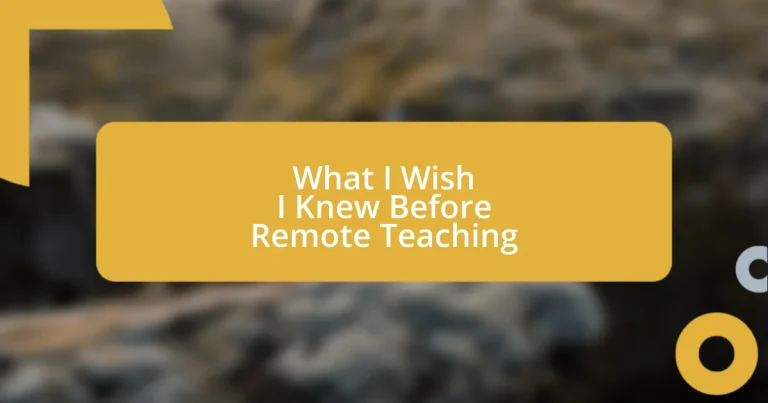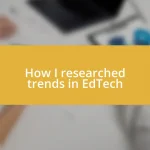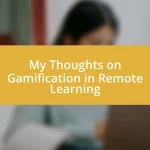Key takeaways:
- Maintaining student engagement in remote teaching is challenging; using interactive tools and fostering personal connections are essential for participation.
- Effective lesson planning requires clarity, adaptability, and a mix of teaching methods to cater to diverse learning styles.
- Regular communication with students and parents, including personalized outreach, enhances community feeling and improves student motivation.
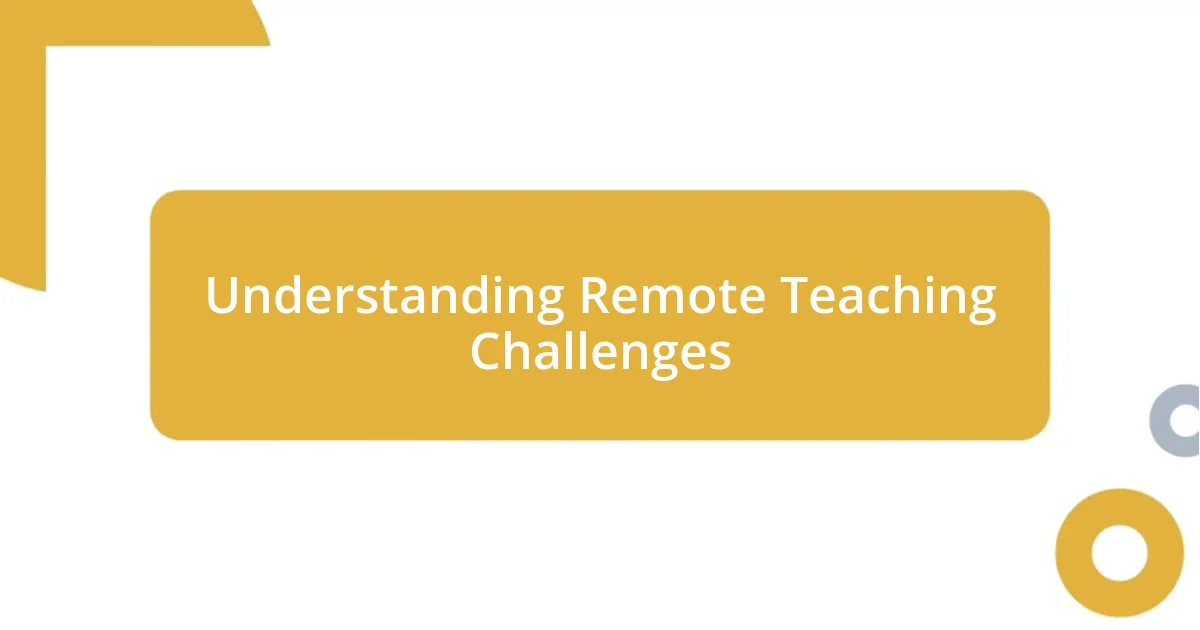
Understanding Remote Teaching Challenges
One of the most significant challenges I faced in remote teaching was maintaining student engagement. I remember the days when I would prepare an exciting lesson, only to see my students’ faces blurred on screen, their attention split between the lesson and distractions at home. It made me wonder—how can I bring the energy of a classroom into the virtual world?
Additionally, technical issues can be a real stumbling block. I once spent a whole session troubleshooting audio problems, only to realize later that my students couldn’t hear me. That experience taught me the importance of having a backup plan and being prepared for the unexpected, a skill that’s crucial in remote teaching.
I also found that building community in a virtual environment is more challenging than I initially anticipated. I missed the spontaneous interactions that spark connections among students. How do you foster relationships digitally? I learned that creating small breakout groups can help, but it still feels like an uphill battle to evoke the same warmth and familiarity as face-to-face learning.
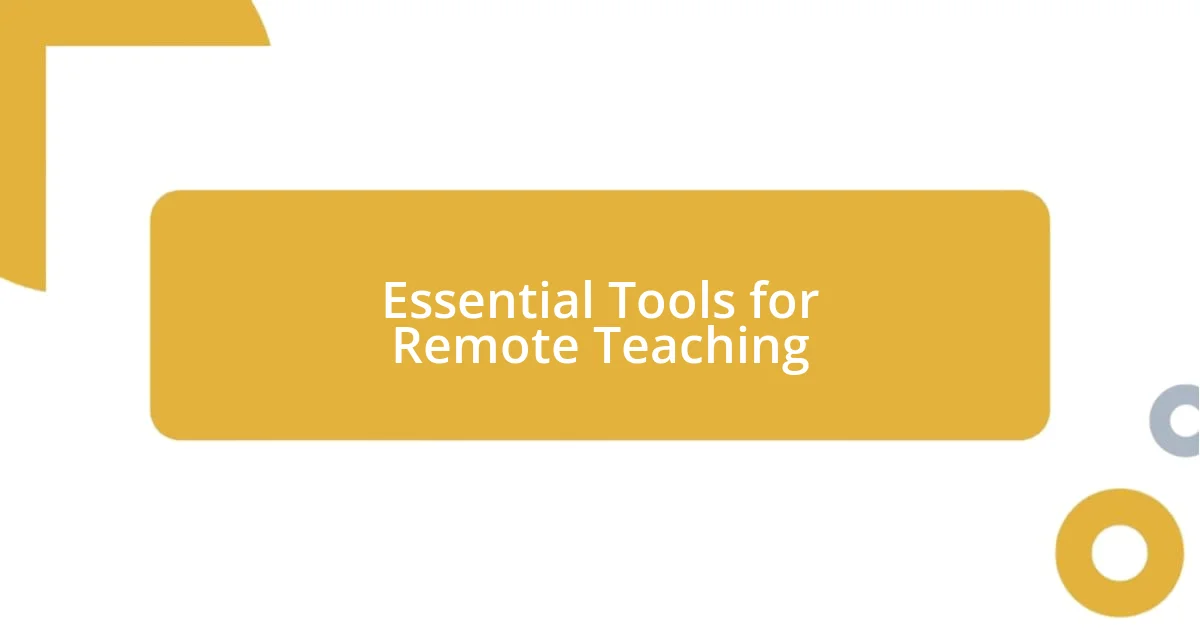
Essential Tools for Remote Teaching
One of the most crucial aspects I realized was the importance of using effective tools. Initially, I relied heavily on standard video conferencing platforms, but I quickly discovered that integrating interactive tools could elevate my lessons. For instance, applications like Kahoot! and Padlet not only facilitate participation but also bring a playful element to learning, which I found to be vital for keeping students engaged.
As I explored various tools, I noticed that each platform offers unique features that cater to different teaching needs. For example, Google Classroom serves as an excellent hub for assignment organization and communication, while platforms like Zoom or Microsoft Teams provide robust video capabilities. The key is to identify what resonates with your teaching style and your students’ learning preferences. I’ve had moments where switching tools mid-lesson brought my class back to life, and it’s those experiences that underscore the value of versatility in remote teaching.
The collection of tools you choose can profoundly impact your effectiveness as a remote educator. I often reflect on the days when I struggled with simple file sharing, realizing that a structured approach to tool selection would have saved me countless headaches. Here’s a comparison of some essential tools I’ve found most beneficial:
| Tool | Purpose |
|---|---|
| Google Classroom | Assignment management and communication |
| Zoom | Video conferencing and breakout rooms |
| Kahoot! | Interactive quizzes and engagement |
| Padlet | Collaborative brainstorming |
| Flipgrid | Video discussion and student response |
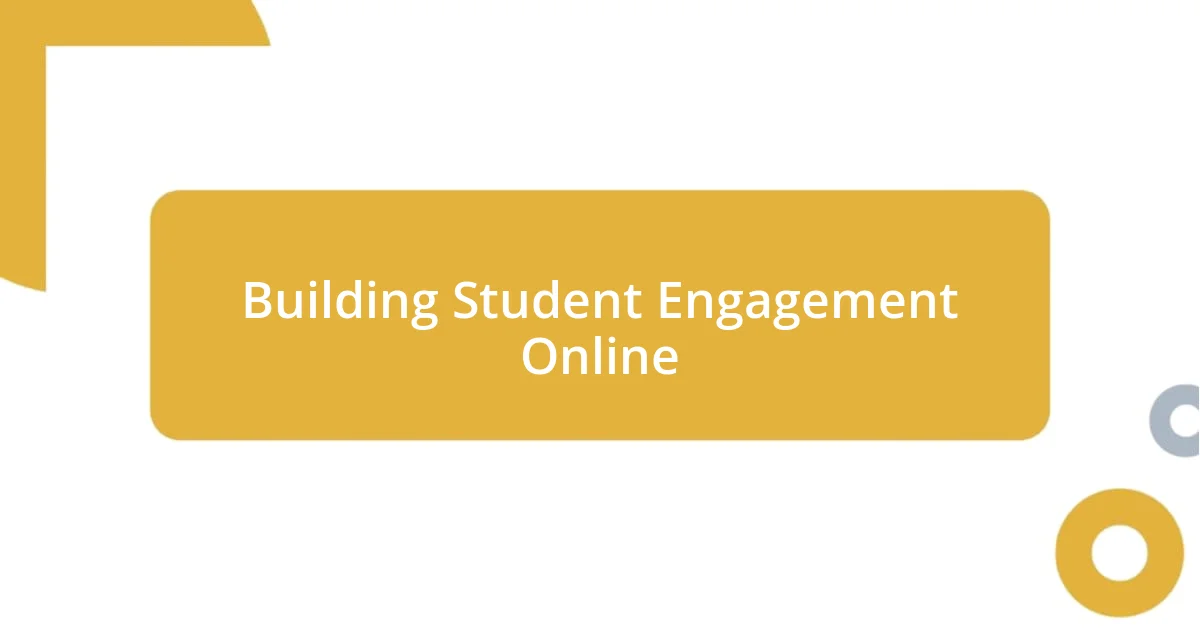
Building Student Engagement Online
Building student engagement online was often an elusive goal for me. I remember one lesson where I introduced a dynamic discussion topic, but my enthusiasm hit a wall when I saw only a few students participating. It was disheartening. I realized that without the structure of physical presence, I needed to create interaction intentionally. One effective strategy I adopted was using polls and real-time feedback tools. I found that when students had opportunities to voice their opinions or answer fun quiz questions, they became more involved.
To actively engage students, I found these approaches helpful:
– Utilize Breakout Rooms: Small groups encourage discussion and make participation less intimidating.
– Incorporate Interactive Tools: Platforms like Mentimeter let students share their thoughts anonymously, making it easier for shyer students to join in.
– Gamify Learning: Adding competition through quizzes or team challenges can transform the atmosphere. I’ve seen students light up when points are on the line!
– Regular Check-ins: Use quick surveys to gauge interest levels or address issues, showing students that their input matters.
– Create a Personal Connection: Sharing snippets of my day or interests helped humanize the experience, making students more comfortable sharing their stories, too.
These strategies helped me turn disengagement into interaction, fostering a more vibrant online classroom.
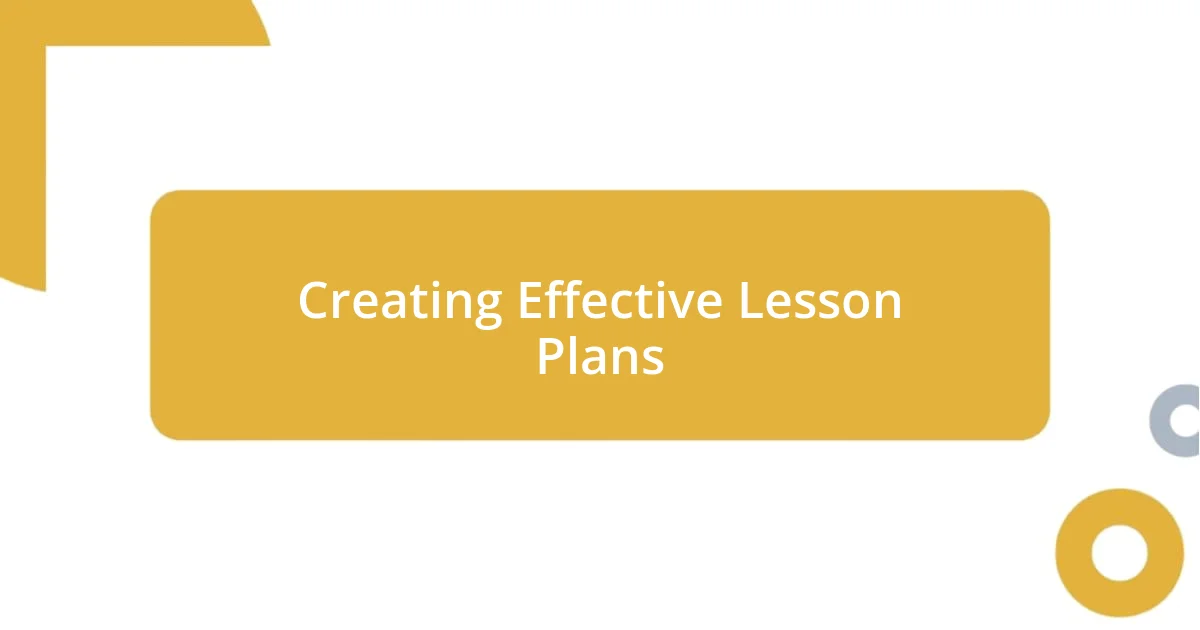
Creating Effective Lesson Plans
Creating effective lesson plans for remote teaching has been quite the journey for me. One element I learned to prioritize was clarity. In one of my early lessons, I laid out an ambitious plan but quickly saw my students lost in confusion. That experience taught me the power of a simple, well-structured outline. I now focus on defining clear objectives and presenting materials in manageable segments. It’s amazing how something as simple as an agenda can guide students and make them feel more engaged.
Another key takeaway has been the importance of incorporating diverse teaching methods. I made a point to mix direct instruction with hands-on activities, which helped cater to different learning styles. For example, integrating brief video clips or relevant articles into my plans allows students to explore and engage with the content on multiple levels. Reflecting on those initial, clunky lessons, I realize now that balancing different formats brings more life to the material, keeping students interested and involved.
Lastly, I’ve learned to build in flexibility in my lesson plans. What works perfectly for one group may completely flop with another. The first time I tried a group project, I was perfectly prepared—but so was my class for a chaotic, hilarious meltdown! Now, I design my plans with contingency options, ensuring that if a lesson doesn’t resonate, I have alternatives to pivot to. It’s a lesson in adaptability, reminding me to embrace the fact that teaching is often as much about the unexpected moments as it is about the planned content. How do you ensure you’re ready for those surprises? It’s all part of the teaching adventure!
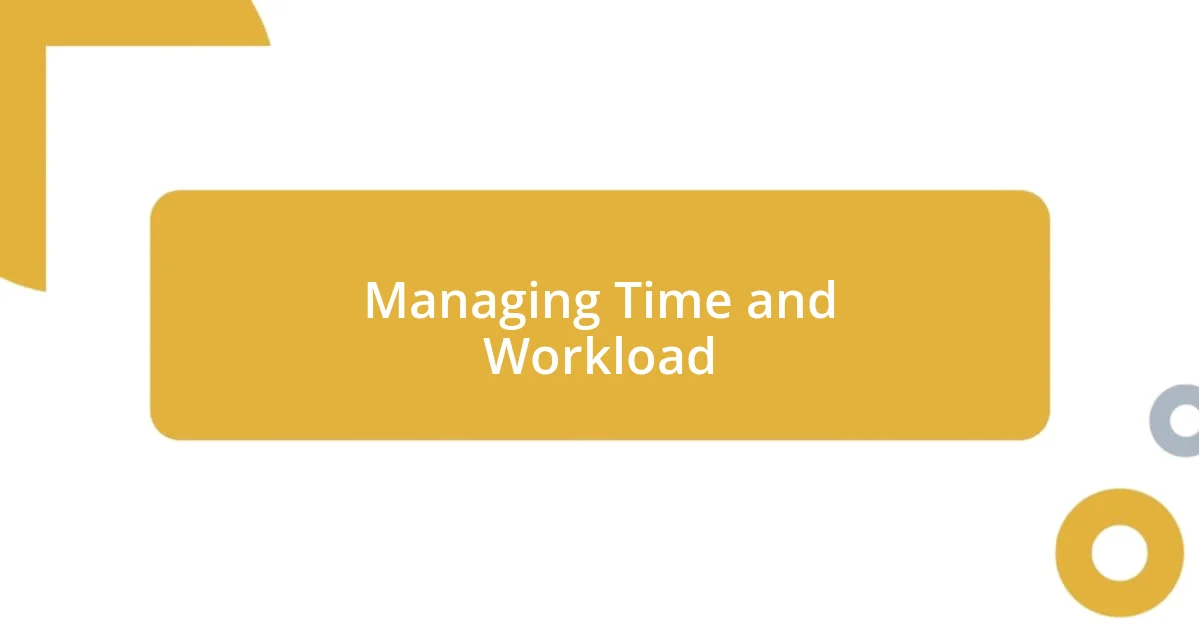
Managing Time and Workload
Managing time while juggling various responsibilities in remote teaching is something I initially overlooked. I recall early on feeling the pressure of endless tasks piling up, from grading to creating content, and it felt overwhelming. I soon realized that setting specific time blocks for each task helped me regain control. By creating a daily schedule and strictly adhering to it, I found that my productivity surged, and I could actually enjoy my free time without the nagging thought of unfinished work.
One tool that became indispensable for me was a digital planner. It allowed me to visualize my week, making it easier to balance lesson planning, communication with students, and even my personal commitments. I remember one particularly hectic week where every minute counted. By using color-coded blocks for different activities, I could see at a glance where my time was going. This not only streamlined my workload but also provided a sense of accomplishment as I ticked off completed tasks.
Thinking back, I wish I had known earlier about the importance of self-care during these busy times. I often found myself buried in work without breaks, leading to burnout. Incorporating short breaks—like a quick walk or a few minutes of stretching—became crucial for rejuvenation. The simple act of stepping away from my screen helped me return with a clearer mind. Have you experienced the weariness of constant online engagement? Trust me, carving out time for yourself is just as important as any lesson you plan to teach.
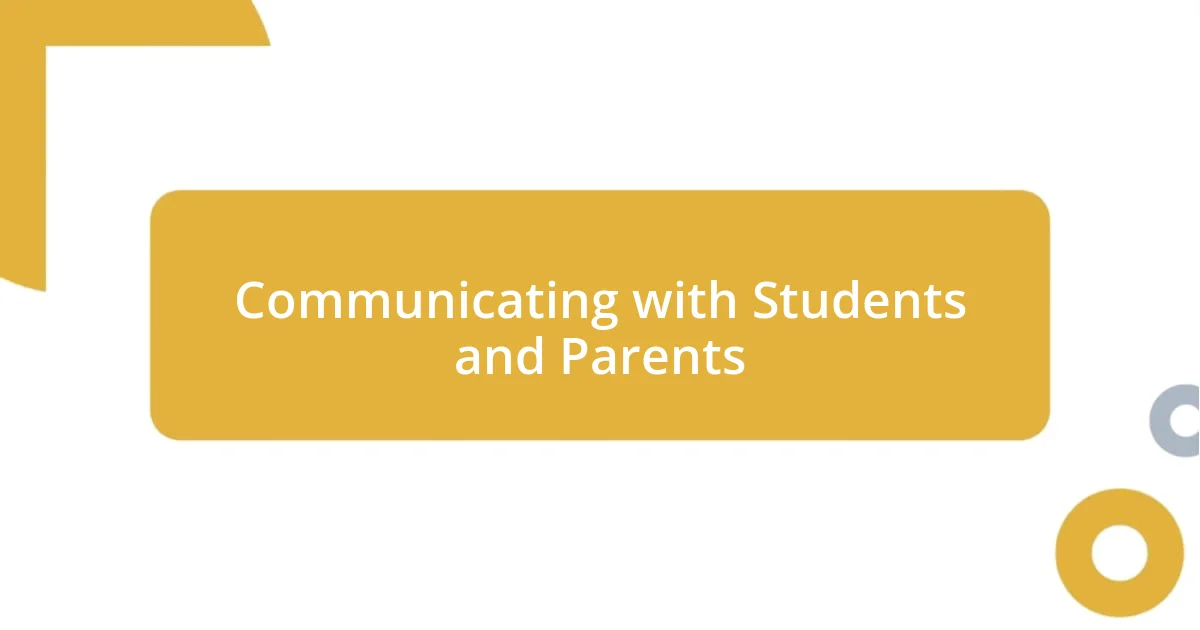
Communicating with Students and Parents
Engaging with students and parents in a remote teaching environment reshaped my expectations of communication. Initially, I believed that sending a quick email was sufficient, but I quickly learned that it often wasn’t enough to establish a strong connection. In my experience, I found that hosting weekly video check-ins not only made it easier for parents to stay updated but also fostered a sense of community among students. These calls became a platform for open dialogue, allowing everyone to express concerns and share successes.
I vividly remember a particular instance when a student was struggling with assignments, and the parent reached out during one of our calls. Instead of just addressing the issue via email, we brainstormed strategies together in real-time. It was remarkable to witness the shift in the student’s motivation after that discussion. I realized that when parents felt included in the educational process, it significantly improved student engagement and accountability. Have you ever noticed how a little collaboration can make a huge impact?
Another important aspect I learned is the power of personalized communication. Early on, I would send generic updates, but I felt a lack of response and engagement. By simply adding personal notes, like acknowledging a student’s birthday or celebrating their achievements, I began to see a transformation. This attention to detail made families feel valued and appreciated. Knowing that they weren’t just another name on a roster changed the entire dynamic of the classroom. As I reflect on this, I can’t help but wonder: how much more connected could we all feel if we prioritized our relationships as much as the curriculum?
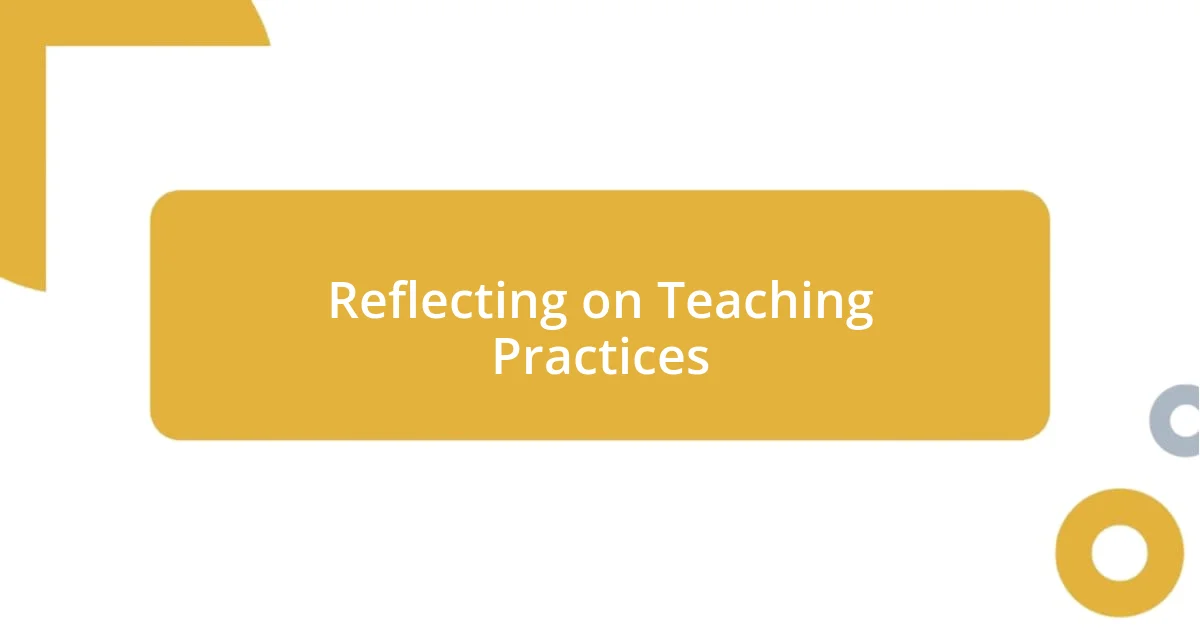
Reflecting on Teaching Practices
Reflecting on my teaching practices has been a transformative experience. In those early days of remote teaching, I often relied on my usual methods, thinking they would seamlessly transition online. However, I quickly realized they fell flat without the same personal touch that in-person classes offered. I remember the moment I decided to dive deeper into my teaching philosophy, asking myself, “What truly engages my students?” Re-evaluating my approach not only reignited my passion for teaching but also led to more meaningful interactions with my students.
Looking back, I can see how vital it is to consistently assess what’s working and what’s not. I found myself frequently reviewing lesson effectiveness. After one particular unit, where engagement had noticeably dipped, I sought feedback from my students. Their insights were eye-opening! They expressed a desire for more interactive activities instead of traditional lectures. That experience taught me the importance of adaptability and being receptive to students’ needs. Have you considered how feedback could reshape your own practices?
Reflecting on those moments has taught me one undeniable truth: teaching is a journey of constant evolution. I’ve embraced the idea that the best lessons come from trial and error. One recent challenge involved integrating technology, where I initially felt overwhelmed. Yet, after experimenting with various tools and gathering input from my students, I discovered apps that captivated their attention and enhanced learning. It was a reassuring reminder that growth often lies outside our comfort zones. Are we not all striving for better ways to inspire and connect with our learners?












